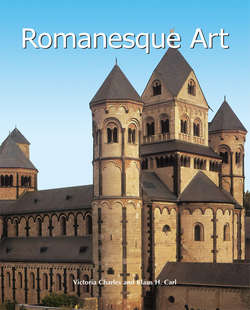Romanesque Art

Реклама. ООО «ЛитРес», ИНН: 7719571260.
Оглавление
Victoria Charles. Romanesque Art
Introduction
I. The Romanesque System of Architecture
II. Romanesque Monuments in Central Europe
Germany
Stiftskirche (collegiate church) St Cyriacus in Gernrode
Michaeliskirche (St Michael’s Church) of Hildesheim
Other Ecclesiastical Buildings
Stiftskirche in Bad Hersfeld
Mainz Cathedral
Speyer Cathedral
Worms Cathedral
Abteikirche (Monastic church) Maria Laach
Churches in Cologne
The Double Church of Schwarzrheindorf
Ecclesiastical Architecture in Westphalia
Southern Germany
Bavaria – Bamberg Cathedral
Hesse – Limburg Cathedral
Thuringia – Naumburg Cathedral
Liebfrauenkirche (Church of Our Lady) in Arnstadt
Abteikirche (Abbey Church) of Heisterbach
Northern Germany – Cathedrals and Churches
Lübeck and Ratzeburg Cathedrals
Loccum Monastery
Secular Buildings
Wartburg Castle
The Castles and Palaces in Goslar and Braunschweig
The Imperial Residence of Gelnhausen
Austria
Gurk Cathedral
St Paul in the Lavant Valley
The Town Parish Church in Friesach
Italy
The Cathedrals of Monza, Brescia and Cividale
Pisa Cathedral
The Cathedrals in Parma, Modena and Ferrara
The Cosmati
France
Northern France
Notre-Dame Cathedral and the Bayeux Tapestry
Royaumont Abbey
Eastern France: Alsace
Western France
Poitou
Notre-Dame-la-Grande church in Poitiers
Southern France
Aveyron
Gellone Abbey
The churches of Saint-Gilles-du-Gard and Saint-Trophime d’Arles
Central France
Fontevraud Abbey
Saint-Benoît-sur-Loire
Cluny Abbey
Paray-le-Monial
Basilica Sainte-Marie-Madeleine, Vézelay
Fontenay Abbey
Cathedral of Saint-Lazare in Autun
Pontigny
The Church of Saint-Andoche in Saulieu
Auvergne
Southwest France
Abbey Saint-Pierre in Moissac
Saint-Sernin of Toulouse
Spain
The Cathedral of Santiago de Compostela
United Kingdom
Durham Cathedral
St Albans Cathedral
Clonfert Cathedral
Scandinavia
Poland
III. Romanesque Sculpture and Painting
Sculpture
Stone Sculpture
The Externsteine
Sculpture in the Twelth and Thirteenth Centuries
Central Germany
Southern Germany
France
Vézelay
Moissac
Italy
The Art of Woodworking and Gold, Silver and Bronze Casting
Painting
Illuminated Manucripts
Glass Painting
Mural and Panel Painting
Germany
France
Italy
Conclusion
Bibliography
Отрывок из книги
Nave, Abbey Saint-Michel-de-Cuxa, Codalet (France), c. 1035.
Gradually, however, ancient Roman art was rediscovered. Emperor Charlemagne, who, around 800 A.D., made every effort to revive the Roman Empire and even considered himself the successor to the Western Roman Emperors, so furthered the interest in ancient art that it can be referred to as a “Carolingian Renaissance”. He sent his people out to bring ancient artefacts back to his court, and there actually are some examples of Carolingian sculpture which, in a naive manner, emulate these models. At the same time, Carolingian portable art blossomed, and mainly produced ivory carvings and metalwork as well as a few small bronze statues. In architecture, the Roman style with its round arches, massive walls, and barrel vaults became established.
.....
10. Turrets of the eastern transept
The two towers framing the western façade were main elements of church architecture during the prime of the Romanesque style. In the course of the Gothic period, they developed into splendid specimens throughout ecclesiastical architecture, behind which the rest of the structure was sometimes even neglected. The western towers, however, did not remain alone even during the Romanesque period. Among the master builders a demand circulated, based on their early aesthetic considerations, to interrupt certain parts of the church roof, which usually appeared monotonous with its steeply rising gable forms, with tower-like structures and to thus denote these parts as extraordinarily pleasant and important. One location emerged as particularly suitable; the intersection of the nave and transept roofs above the crossing. In the older days, only a small tower lodged on the roof ridge, the so-called ridge turret, was installed, which was also still used later when lacking funds prevented the erection of a massive tower of imposing size.
.....